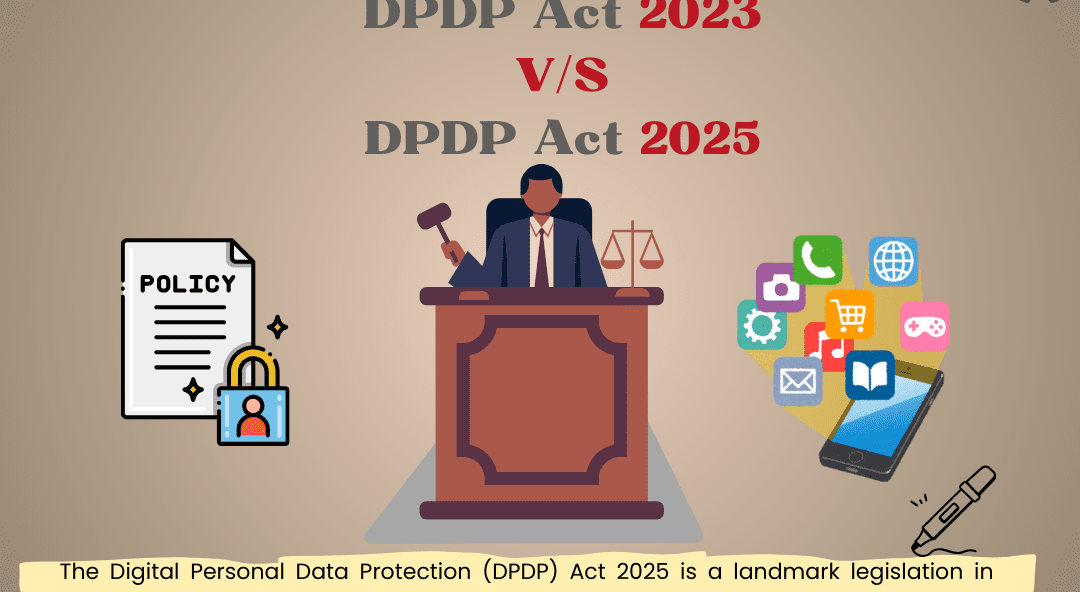
Digital Personal Data Protection
-
It appears that you want to know how the DPDP (Data Protection and Digital Privacy) rules and regulations of 2023 and 2025 differ from one another. Here’s an explanation if you’re talking about the Digital Personal Data Protection (DPDP) Act, 2023 in India or a comparable data protection framework:
Digital Personal Data Protection (DPDP) Act, 2023 (India)
-
A law known as the DPDP Act, 2023 was passed in India to control the gathering, storing, and processing of personal data. It places a strong emphasis on upholding people’s rights while making sure companies manage data sensibly.
Potential Differences in 2023 vs. 2025:
- Implementation Stage:
- 2023 saw the introduction of the DPDP Act, which is probably still in the early stages of implementation. Regulations, guidelines, and compliance frameworks are being created. Companies are adjusting to new legal constraints during this transitional phase.
- 2025: The Act may be fully implemented by this year, with sanctions for noncompliance. Companies are supposed to be more mature in their adherence to the law.
Awareness and Adoption:
2023: People and companies may still be becoming more conscious of their rights and privacy around data.
2025: There will probably be a greater awareness of data protection among the general public and businesses. People may take more proactive steps to exercise their data rights, such as the right to consent or erasure.
Ecosystem Changes:
2023: Businesses are establishing Data Protection Officers (DPOs) and coordinating policies as the ecosystem adapts to the DPDP Act.
2025: The ecosystem should have a solid foundation, with audit procedures, defined rules, and established legal precedents governing data handling.
Technological Impact:
2023: To comply with legal requirements, privacy-enhancing technologies (such as encryption and anonymization) are first adopted.
2025: Stricter regulatory oversight, improved consumer tools for managing consent, and more sophisticated use of AI and automation for compliance.
The Data Protection and Digital Privacy (DPDP) Act, or its equivalents in different jurisdictions, has undergone significant changes over time to address the evolving digital landscape. Here’s an analysis based on the given points:
1. Key Changes in Scope
- Initial Scope: Early data protection laws were limited to safeguarding basic personal data collected by government or private entities. For instance, the Data Protection Directive (1995) in the EU focused on harmonizing data privacy across member states.
- Expansion: Modern iterations, such as the GDPR (2018) and similar acts worldwide (e.g., India’s DPDP Act, 2023), expanded to include:
- Non-personal data and metadata under certain circumstances.
- Cross-border data flows and international data processing.
- Emerging technologies like AI, IoT, and biometric data collection.
- Sector-Specific Adaptations: Recent updates increasingly cater to specific industries, such as healthcare and finance, requiring compliance with both general and sector-specific regulations.
2. Penalties Comparison
- Earlier Penalties: Older regulations imposed modest fines or warnings, focusing on guiding organizations toward compliance.
- Modern Penalties:
- Heavier fines: For example, the GDPR allows penalties of up to €20 million or 4% of annual global turnover, whichever is higher.
- Tiered Penalty Systems: More severe breaches attract higher fines.
- Public Naming: Naming and shaming non-compliant organizations are increasingly used to enforce accountability.
3. Individual Rights
- Original Focus: Initial laws emphasized basic privacy rights, such as the right to access and correct personal data.
- Enhanced Rights:
- GDPR: Introduced rights like data portability, the right to be forgotten, and the right to restrict processing.
- DPDP Act (India): Simplified rights such as data correction and grievance redressal but lacked some robust elements like automated decision-making rights.
- Evolving Rights: Growing recognition of digital rights, including protection against algorithmic biases, consent-based profiling, and the right to explanation in AI-driven decisions.
4. Technological Relevance
- Past Limitations: Older frameworks struggled to address emerging technologies like big data and real-time processing due to their static nature.
- Current Relevance:
- Provisions to regulate AI, automated decision-making, and IoT ecosystems.
- Acknowledgement of blockchain’s challenge to “data erasure” rights.
- Compatibility with cloud storage, edge computing, and global data transfers.
- Future-Forward Adaptations: Anticipation of quantum computing and other disruptive technologies is leading to more flexible, principle-based regulations rather than prescriptive ones.


